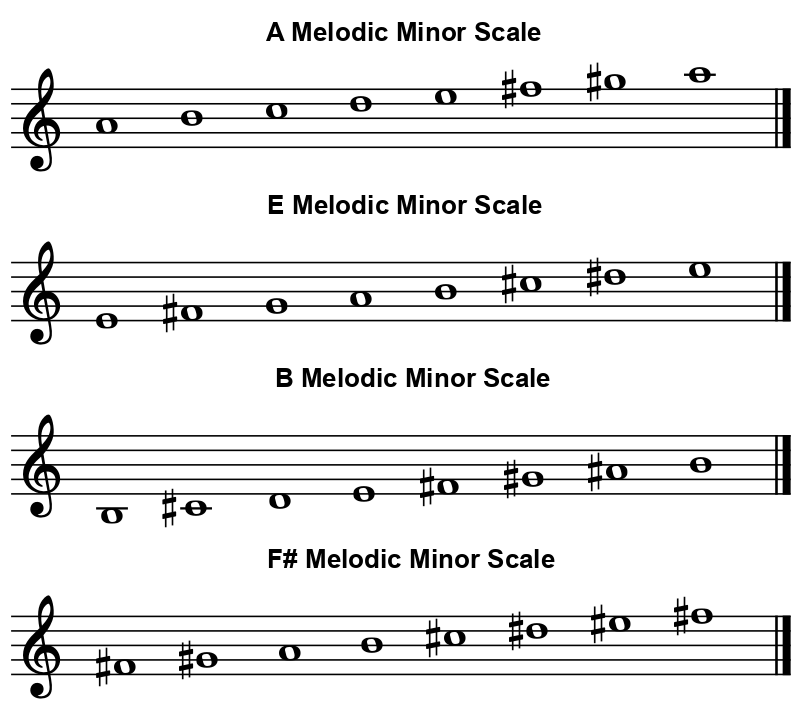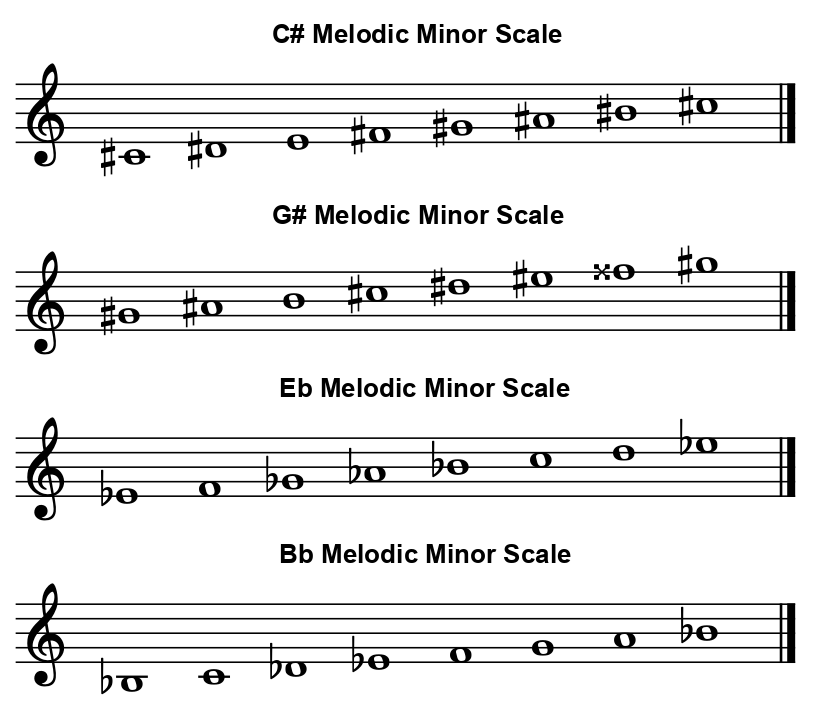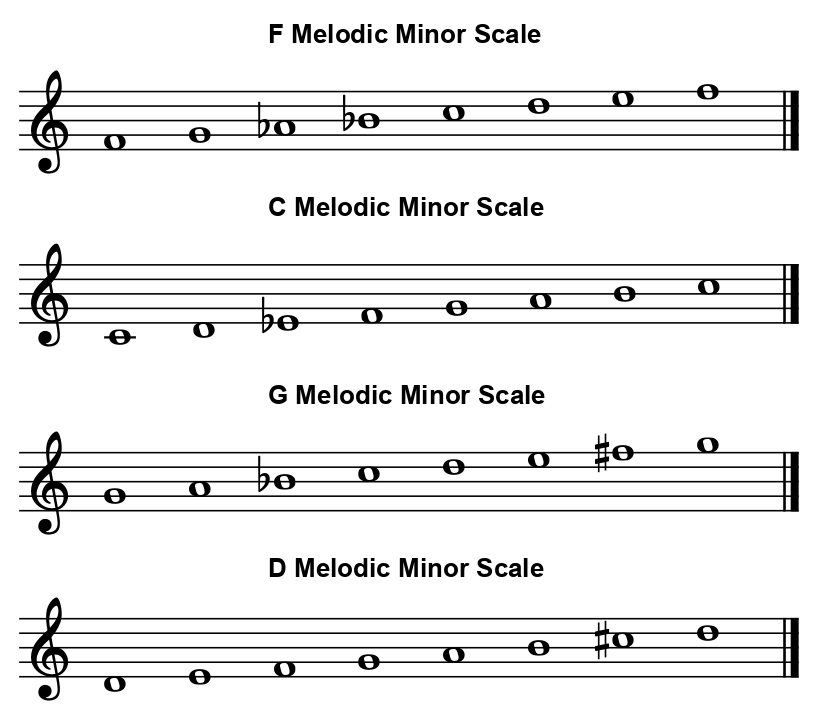The melodic minor scale is a seven-note scale, identical to the natural minor scale but with the sixth and seventh scale degrees raised a half step each.
It is also identical to a major scale but with the third scale degree lowered a half step.
This post will cover how to construct a melodic minor scale by:
- Altering a natural minor scale.
- Altering a major scale.
It will also provide a common fingering for the melodic minor scale along with instruction on how to play it on a guitar in any key.
Construct a Melodic Minor Scale: Alter a Natural Minor Scale
The difference between a natural minor scale and a melodic minor scale with the same root note is that the sixth and seventh scale degrees in the melodic minor scale are raised a half step each.
So an easy way to construct a melodic minor scale is by raising the sixth and seventh degrees of the natural minor scale with the same root note a half step each.
Construct an A Melodic Minor Scale
To construct an A melodic minor scale:
- Write the notes in an A natural minor scale on a staff.
- Raise the sixth and seventh notes a half step each — from F and G to F# and G# (fig.1).
Fig.1


So an A melodic minor scale contains the notes A, B, C, D, E, F# and G#.
Construct a D Melodic Minor Scale
To construct a D melodic minor scale:
- Write the notes in a D natural minor scale on a staff.
- Raise the sixth and seventh notes a half step each — from Bb and C to B and C# (fig.2).
Fig.2


So a D melodic minor scale contains the notes D, E, F, G, A, B and C#.
Construct a Melodic Minor Scale: Alter a Major Scale
We can also construct a melodic minor scale is by altering a major scale.
The scale formula for a melodic minor scale is 1, 2, b3, 4, 5, 6, 7.
A melodic minor scale contains the first, second, flatted third, fourth, fifth, sixth and seventh degrees of the major scale with the same root note.
So we can construct a melodic minor scale by lowering the third scale degree of the major scale with the same root note a half step.
Construct an A Melodic Minor Scale
To construct an A melodic minor scale:
- Write the notes in an A major scale on a staff.
- Lower the third note a half step from C# to C (fig.3).
Fig.3


Once again, an A melodic minor scale contains the notes A, B, C, D, E, F# and G#.
Construct a D Melodic Minor Scale
To construct a D melodic minor scale:
- Write the notes in a D major scale on a staff.
- Lower the third note a half step from F# to F (fig.4).
Fig.4


All 12 Melodic Minor Scales
All 12 melodic minor scales are shown in fig.5.
Fig.5



Scale Characteristics
The melodic minor scale is considered a minor scale because it contains a flatted third scale degree but it sounds brighter than a natural minor scale because of the raised sixth and seventh scale degrees.
Melodic Minor Scales on a Guitar
A common fingering for a melodic minor scale is shown in fig.6.
Fig.6

This fingering will allow you to play a melodic minor scale starting on any note:
- To play an A melodic minor scale, start the pattern on the A on the sixth string, fifth fret (fig.7a).
- To play a D melodic minor scale, start the pattern on the D on the sixth string, 10th fret (fig.7b).
Fig.7

Traditional Melodic Minor Scales vs. Jazz Melodic Minor Scales
There are actually two different versions of a melodic minor scale:
- The traditional melodic minor scale.
- The jazz melodic minor (or jazz minor) scale.
Traditional Melodic Minor Scale
A traditional melodic minor scale has two different structures, one that ascends and one that descends.
When ascending, the traditional melodic minor scale includes the raised sixth and seventh scale degrees (fig.8a).
When descending, the traditional melodic minor scale includes the flatted sixth and seventh scale degrees, as they are in a natural minor scale (fig.8b).
Fig.8


The reason for the two structures is that the raised sixth and seventh scale degrees tend to pull up toward the tonic note in an ascending melody, where they resolve strongly.
But in a descending melody, the flatted sixth and seventh scale degrees create more of a pull down toward the fifth scale degree, where they resolve.
Jazz Melodic Minor (or Jazz Minor) Scale
The jazz minor scale has the same structure in both ascending and descending forms and is more commonly used today, especially in jazz music.
In this instructional series, when I use the term melodic minor scale, I am referring to the jazz minor scale that uses the same structure both ascending and descending.
Related Posts
Related posts include:
- The Major Scale.
- The Minor Scale I: The Relative Approach.
- Harmonizing the Melodic Minor Scale I: Triads.
- Harmonizing the Melodic Minor Scale II: Seventh Chords.
- Modes of the Melodic Minor Scale I: The Relative Approach.
- Modes of the Melodic Minor Scale II: The Parallel Approach.
- Modes of the Melodic Minor Scale III: Soloing.
